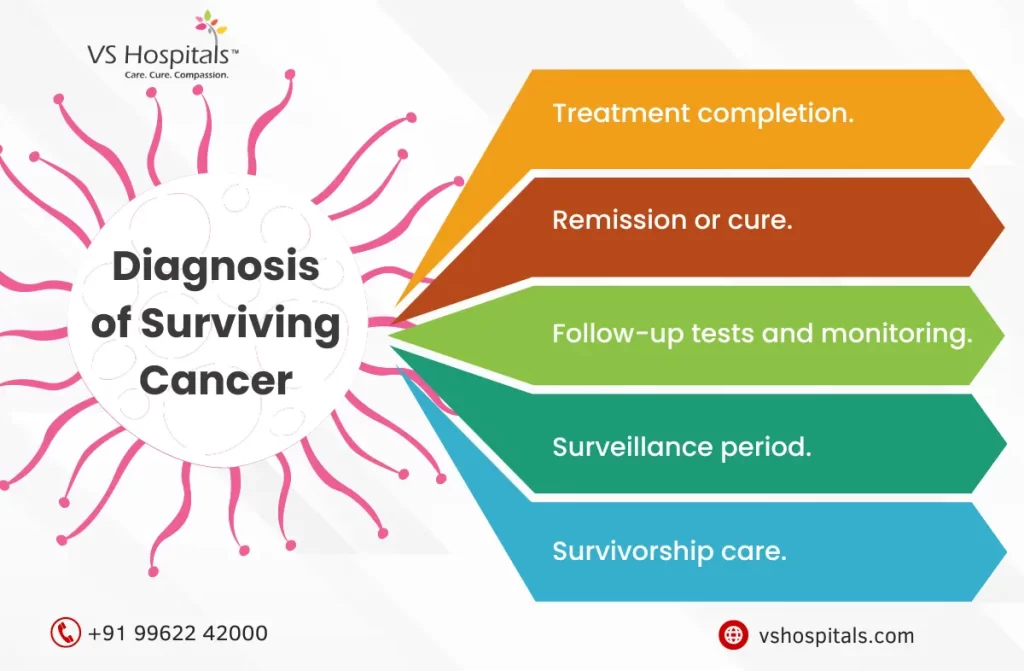The cancer survival rate in India varies due to factors like cancer type, stage at diagnosis, healthcare access, and socioeconomic conditions. Late detection is a challenge, with limited awareness, screening, and healthcare infrastructure. The availability and affordability of advanced treatments are limited, hindering access for many.
Improved awareness, expanded screening programs, enhanced healthcare infrastructure, and affordable treatment options are crucial for raising the cancer recovery rate in India.
Cancer Survival Rate in India
Understanding Cancer: The Internal Perspective
Understanding cancer is not difficult if we start looking at cancer from the inside. Cancer originates within the cells, which can detach from a malignant tumor and proliferate in another area of the body, leading to the formation of a secondary tumor. Cells in these tumours are abnormal and divide without control or order.
They have the ability to infiltrate and harm neighboring tissues and organs. The growth of cells occurs through a process of division, where one cell divides into two, and two into four (referred to as daughter cells), and so on.

Typically, there are stringent regulations governing the growth of cells, determining when they can or cannot proliferate. Unlike malignant tumors, cells within benign tumors do not metastasize or spread to other parts of the body. Most important, benign tumours are rarely a threat to life.
Cells deprived of oxygen die and decay, which is why some cancers have an odor. The process known as angiogenesis refers to the formation of new blood vessels. You can also compare this with the cancer survival rate in India to understand it better.
The Importance of Early Detection and Diagnosis
- Increased Survival Rates: Early detection significantly raises the chances of successful treatment and long-term survival.
- Timely Interventions: Identifying cancer in its early stages allows for more effective and less aggressive treatment options.
- Public Awareness: Education programs can help the public recognize early symptoms, leading to earlier doctor visits and diagnoses.
- Healthcare Access: Improving access to healthcare services ensures more people receive timely screenings and check-ups.
- Medical Infrastructure: Investing in medical infrastructure and training for healthcare professionals enhances early detection capabilities.
- Mortality Reduction: Early diagnosis and treatment reduce cancer-related mortality rates, saving countless lives.
Understanding Cancer Types and Stages
Cancer types and stages categorize tumors based on their characteristics and spread. This classification helps determine prognosis and guides treatment decisions for improved patient outcomes besides enhancing the success rate of cancer treatment in India.
Malignant Tumours: The Threat of Cancerous Growth
Obviously, as you may know already, malignant tumours are cancerous. These tumours contain cells that divide and grow without order. Malignant tumours (cancers) can spread to other tissues or organs nearby or to other parts of the body. This is called metastasis. Malignant tumours are capable of spreading by metastasis and invasion. The term “cancer” mostly applies to malignant tumours. The cancer survival rate in India for this type of cancer is not so positive.
Malignant means that the disease, if not treated, can progress and lead to death. Malignant tumours are cancer. Cancer cells can invade and damage tissues and organs near the tumour. Malignant tissues can invade and damage other tissues and organs.
Cancer cells break away from the tumour, enter the lymphatic system or bloodstream, and start spreading cancer to other parts of the body. The serious part of this is that malignant tumours metastasize to other organs of the body and continue developing unlimitedly and also decreasing the cancer survival rate in India.
Benign Tumours: A Less Threatening Form of Growth
On the other hand, benign tumours can often be removed by surgery, and they are not likely to return. While some testicular tumors can be benign, the majority of them are not. Benign tumours are not usually life-threatening. Benign tumours, although they may cause some health problems depending on their size and location, are not life-threatening.
Benign (noncancerous) tumours can also grow anywhere in your mouth. Benign tumours are well-differentiated – in other words, they differ only slightly in appearance and behaviour from their tissue of origin. These tumours are slow growing and non-invasive, do not spread throughout the body, and will often have a fibrous tissue capsule around them. It increases the success rate of cancer treatment in India.
Treatment Approaches: Tailoring to Cancer Behaviour
Localized Aggressive Cancer:
- Local treatments include surgery and radiation therapy.
- Treatment depends on previous treatment types (e.g., initial surgery).
Post-Surgery Needs:
- Possible requirement for additional surgery.
- May need radiation therapy for comprehensive treatment.
Variable Survival Rates:
- Some cancers have high survival rates in India.
- Other cancers have relatively lower survival rates.
Radiation Therapy:
- Utilizes high-energy X-rays to destroy or impair cancer cells.
- Typically painless and administered on an outpatient basis.
- Effective in targeting affected tissues.
Nature of Radiation:
- A form of energy that is transmitted through waves or particles.
- Originates from radioactive substances.
- Delivered via specialized machines.
Mechanism of Action:
- X-rays or gamma rays penetrate the cell membrane.
- Disrupts the nucleus, inhibiting cell growth and division.
Survivorship and Supportive Care
Survivorship and supportive care are essential components of cancer treatment as they play a major role in improving the cancer recovery rate in India. After completing active treatment, individuals enter the survivorship phase, which requires ongoing support. Survivorship programs provide resources for managing physical and emotional challenges, addressing long-term side effects, and promoting overall well-being.
Supportive care encompasses various services, including palliative care, pain management, psychological support, and rehabilitation. These services aim to improve quality of life, alleviate symptoms, and help individuals adjust to life after cancer besides increasing the success rate of cancer treatment in India. Comprehensive survivorship and supportive care programs are crucial in ensuring holistic care for cancer survivors.
Factors contributing to the low Survival Rate of Breast Cancer in India
Several factors contribute to the lower survival rate of breast cancer in India:
- Late Detection: Many cases are diagnosed at advanced stages, reducing treatment options.
- Limited Awareness: Lack of awareness leads to delayed screenings and preventive measures.
- Stigma and Fear: Sociocultural factors may hinder open discussions and early medical consultations.
- Limited Access to Healthcare: Some regions face challenges in accessing quality healthcare and specialized treatments.
- Genetic Factors: A higher prevalence of aggressive subtypes and genetic factors may contribute.
Addressing these factors through awareness, education, and improved healthcare infrastructure can potentially enhance breast cancer survival rate in India.
State in India with the Highest Cancer Rate
The state with the highest cancer rate in India is Kerala. Known for its high literacy rates and advanced healthcare system, Kerala also faces significant health challenges, with cancer being a major concern. The high incidence of cancer in Kerala can be attributed to several factors, including lifestyle changes, increased consumption of tobacco and alcohol, and higher awareness leading to better reporting and diagnosis of cancer cases.
The state’s robust healthcare infrastructure allows for early detection and treatment, but it also highlights the growing need for effective cancer prevention and control measures. Public health initiatives focusing on reducing risk factors, promoting healthy lifestyles, and improving early detection and treatment are essential to address the rising cancer rates in Kerala. Despite the challenges, Kerala’s proactive approach in healthcare offers a model for other states to follow in combating the cancer epidemic.
Rise of Breast Cancer in India
Breast cancer has emerged as the most common cancer among Indian women, showing a worrying upward trend. Several factors contribute to this rise:
- Lifestyle Changes: Increasing urbanization and lifestyle modifications, including dietary changes, reduced physical activity, and obesity.
- Late Marriages and Childbirth: Delays in marriage and childbirth can increase the risk of breast cancer.
- Lack of Awareness: Limited awareness about early detection and screening practices.
- Genetic Factors: Family history and genetic predispositions.
Efforts are underway to improve awareness, encourage regular screenings, and enhance treatment facilities to combat this growing health concern.
Conclusion
By prioritizing early detection, adopting a healthy lifestyle, exploring appropriate treatment options, and staying informed about advancements, individuals can enhance their chances of successful cancer outcomes. Empowering yourself with knowledge and seeking comprehensive care can make a difference in the battle against cancer.
It is worth noting that the cancer survival rate in India has been improving over the years, thanks to advancements in medical technology and increased awareness. However, specific survival rates may vary depending on the type and stage of cancer.
Read also Health Risk of Poor Nutrition.




